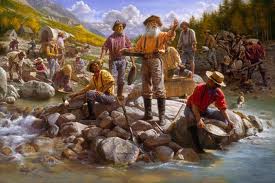Gold artifacts found at the Nahal Kana cave cemetery dated during the 1980s, showed these to be from within the Chalcolithic, and considered the earliest find from the Levant (Gopher et al. 1990). Gold artifacts in the Balkans also appear from the 4th millennium BC, such as those found in the Varna Necropolis near Lake Varna in Bulgaria, thought by one source (La Niece 2009) to be the earliest "well-dated" find of gold artifacts. Gold artifacts such as the golden hats and the Nebra disk appeared in Central Europe from the 2nd millennium BC Bronze Age.

Egyptian hieroglyphs from as early as 2600 BC describe gold, which king Tushratta of the Mitanni claimed was "more plentiful than dirt" in Egypt. Egypt and especially Nubia had the resources to make them major gold-producing areas for much of history. The earliest known map is known as the Turin Papyrus Map and shows the plan of a gold mine in Nubia together with indications of the local geology. The primitive working methods are described by both Strabo and Diodorus Siculus, and included fire-setting. Large mines were also present across the Red Sea in what is now Saudi Arabia.
The legend of the golden fleece may refer to the use of fleeces to trap gold dust from placer deposits in the ancient world. Gold is mentioned frequently in the Old Testament, starting with Genesis 2:11 (at Havilah), the story of The Golden Calf and many parts of the temple including the Menorah and the golden altar. In the New Testament, it is included with the gifts of the magi in the first chapters of Matthew. The Book of Revelation 21:21 describes the city of New Jerusalem as having streets "made of pure gold, clear as crystal". Exploitation of gold in the south-east corner of the Black Sea is said to date from the time of Midas, and this gold was important in the establishment of what is probably the world's earliest coinage in Lydia around 610 BC. From the 6th or 5th century BC, the Chu (state) circulated the Ying Yuan, one kind of square gold coin.

In Roman metallurgy, new methods for extracting gold on a large scale were developed by introducing hydraulic mining methods, especially in Hispania from 25 BC onwards and in Dacia from 106 AD onwards. One of their largest mines was at Las Medulas in León (Spain), where seven long aqueducts enabled them to sluice most of a large alluvial deposit. The mines at Rosia Montana in Transylvania were also very large, and until very recently, still mined by opencast methods. They also exploited smaller deposits in Britain, such as placer and hard-rock deposits at Dolaucothi. The various methods they used are well described by Pliny the Elder in his encyclopedia Naturalis Historia written towards the end of the first century AD.
During Mansa Musa's (ruler of the Mali Empire from 1312 to 1337) hajj to Mecca in 1324, he passed through Cairo in July 1324, and was reportedly accompanied by a camel train that included thousands of people and nearly a hundred camels where he gave away so much gold that it depressed the price in Egypt for over a decade. A contemporary Arab historian remarked:
The Portuguese overseas expansion started in 1415 with the taking of Ceuta, to control the gold trade coming across the desert. Although the caravan trade routes were then diverted, the Portuguese continued expansing southwards along the coast and eventually buying the gold directly (or less indirectly) from the Africans in the Gulf of Guinea.
The European exploration of the Americas was fueled in no small part by reports of the gold ornaments displayed in great profusion by Native American peoples, especially in Central America, Peru, Ecuador and Colombia. The Aztecs regarded gold as literally the product of the gods, calling it "god excrement" (teocuitlatl in Nahuatl), and after Montezuma was killed, most of this gold was shipped to Spain. However, for the indigenous peoples of North America gold was considered useless and they saw much greater value in other minerals which were directly related to their utility, such as obsidian, flint, and slate.
Gold played a role in western culture, as a cause for desire and of corruption, as told in children's fables like Rumplestiltskin, where the peasant's daughter turns hay into gold, in return for giving up her child when she becomes a princess, and stealing the hen that lays golden eggs in Jack and the beanstalk.
 The top prize at the Olympic games is the gold medal.
The top prize at the Olympic games is the gold medal.
There is an age-old tradition of biting gold to test its authenticity. Although this is certainly not a professional way of examining gold, the bite test was not to check if the coin was gold (90% gold coins are fairly strong) but to see if the coin was gold plated lead. A lead coin would be very soft and thus teeth marks would result. Fake gold coins were a common problem before 1932 so weighing a coin and also sliding a coin through a "counterfeit detector" slot was common (making a lead coin thicker would add weight thus why slide it through a measured slot). Most establishments (especially US Western saloons) would never accept a gold (or silver) coin of high value before weighing such an item






